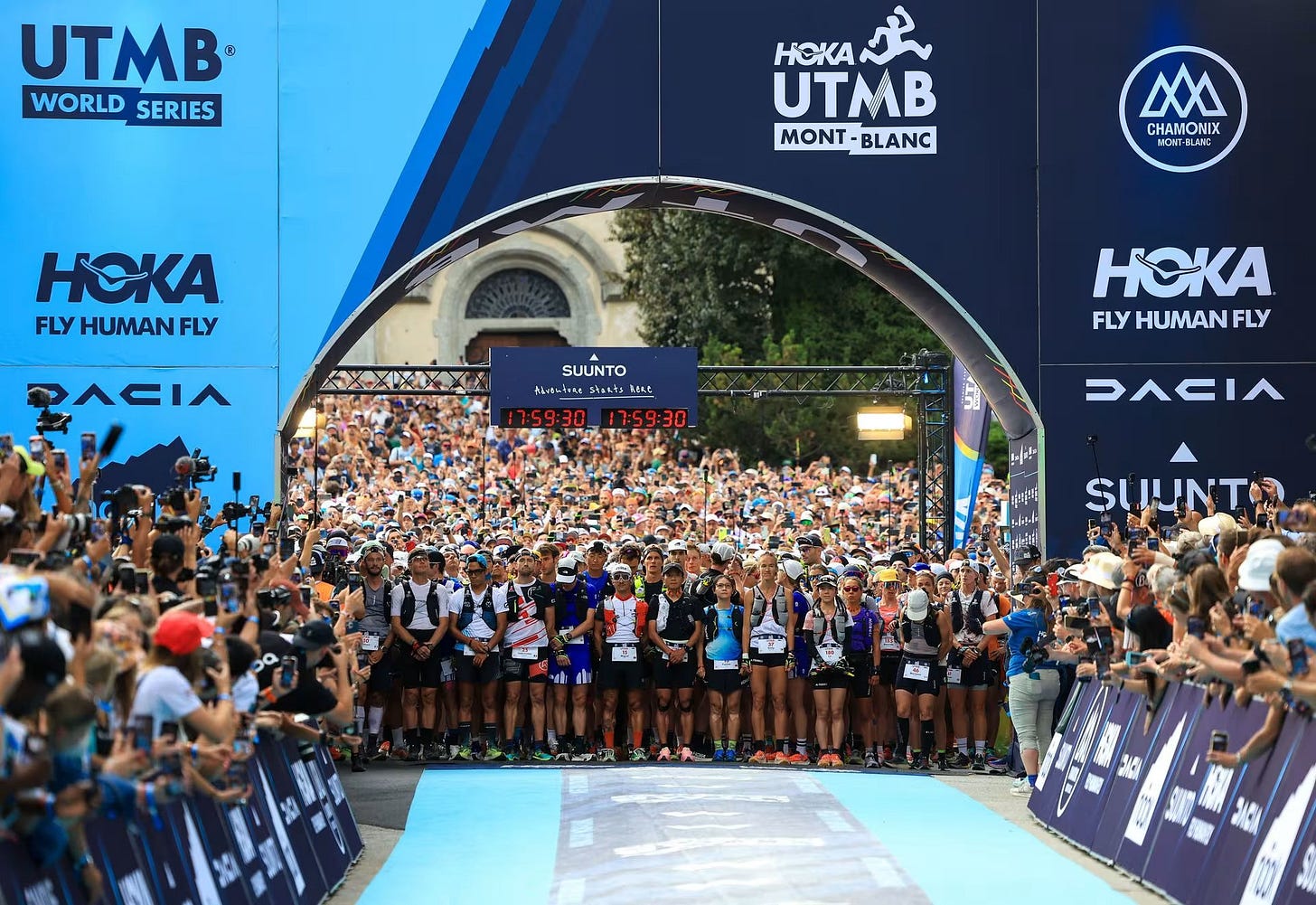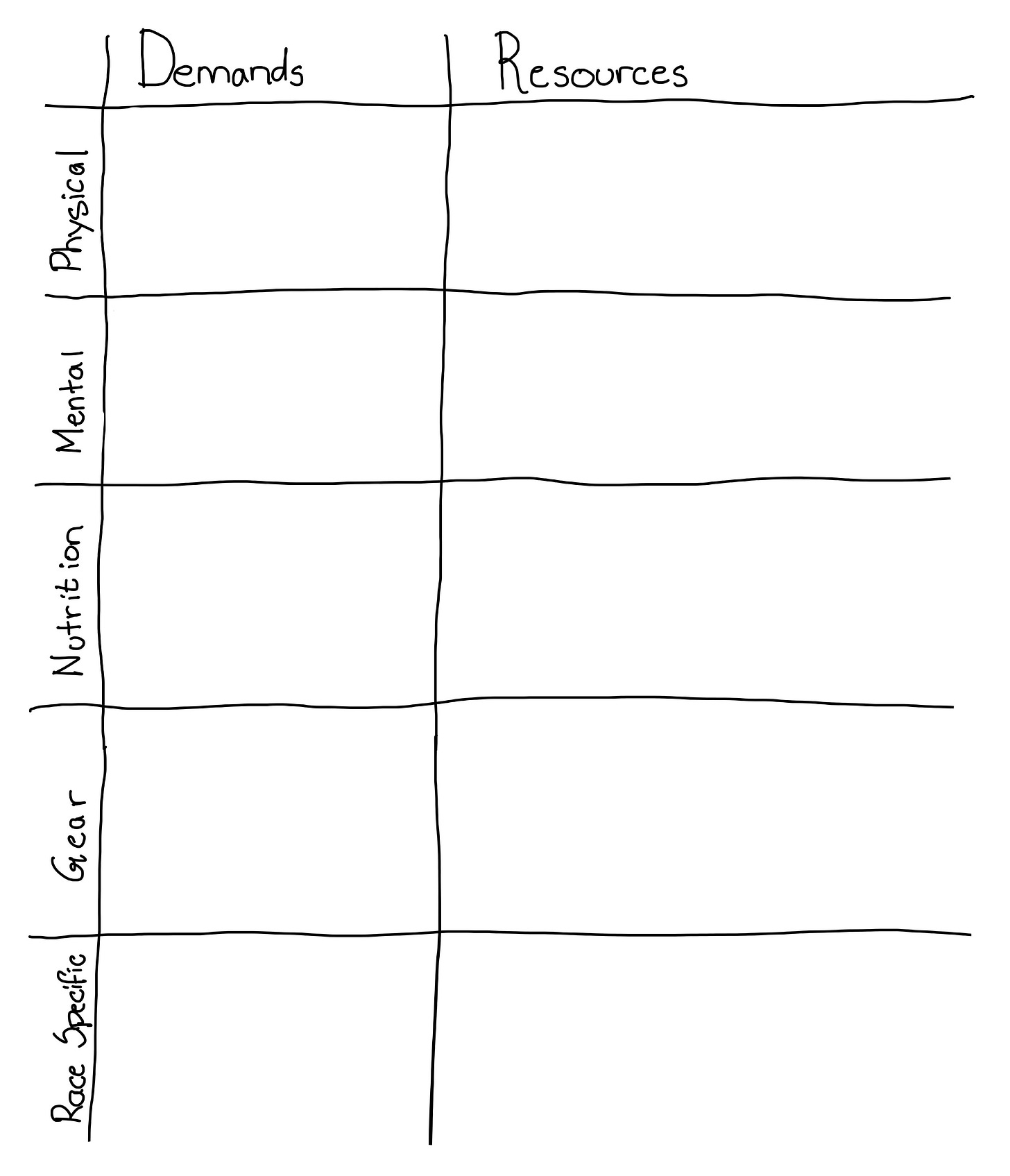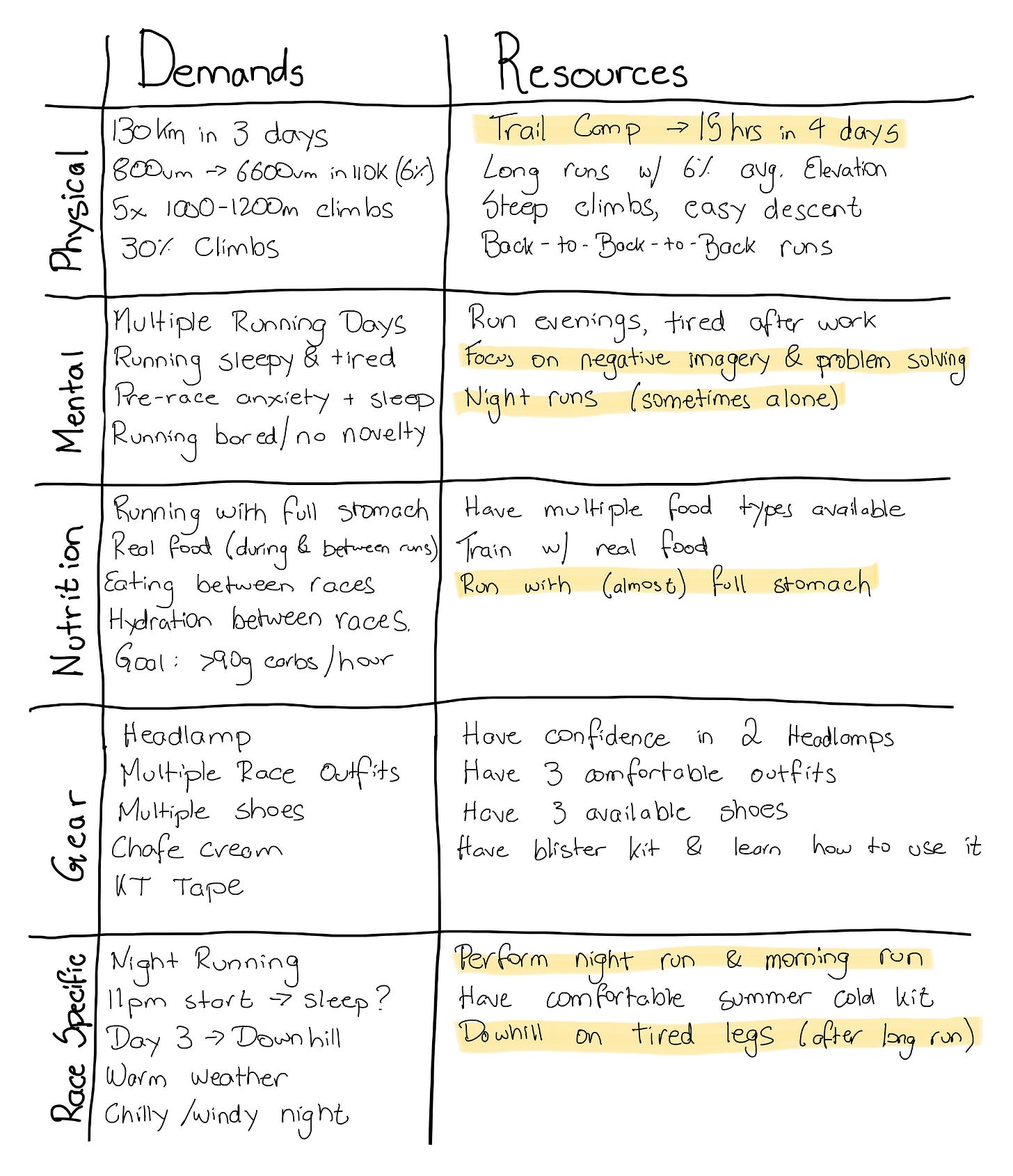The Demands-Resources Model Will Change The Way You Approach Training
The Demands-Resources model balances the demands of the event with your resources, helping you train smarter and build confidence ahead of your big event.
In a previous post, I talked about goal setting and the difference between outcome goals and process goals. The idea was to encourage runners to shift away from focusing solely on results and instead putting a greater emphasis on the process which leads to the outcome since that is what you can actually control.
I followed that up with another post breaking down the training process into 5 key aspects. The goal there was to help runners take a holistic look towards training rather than just over-emphasizing the physical component of training.
This post ties those ideas together by introducing a concept named the Demands-Resources model. This model helps athletes break down the characteristics of an event or race into trainable aspects thus shaping and improving the training process. Let’s dive in!
Literature Underpinning the Demands-Resources Model
I first came across the term “Demands-Resources” on a podcast between Jason Koop and Carla Meijen, where Carla discussed how professional athletes react under pressure.
The conversation was rooted in a scientific paper introducing the theory of challenge and threat states in athletes. The paper explains that when athletes face a competitive situation, their reaction depends on whether they feel equipped to handle it. Essentially, they weigh the perceived demands of the situation against the resources they have to meet those demands.
In an athletic context, demands include everything required to perform well - physical and mental effort, as well as the perceived risk or uncertainty of the event. On the flip side, resources are what the athlete brings to the table: their skills, mental toughness, ability to influence the outcome and support system among others.
The “ratio” of demands to resources determines how the athlete reacts:
High Resources + Low Demands = Best Performance
Low Resources + Low Demands = Moderate Performance
High Resources + High Demands = Moderate Performance
Low Resources + High Demands = Worst Performance

The Race I Never Ran
On the evening of July 27, 2024, I went to bed ahead of my first 100-mile race but unfortunately, I never made it to the start line. I spent the night shivering, worrying, and utterly terrified. Physically, I knew I could finish the race but my mind wouldn’t let me rest. I can’t pinpoint exactly what caused the anxiety, but deep down I felt unready and since I managed to get no sleep at all, I decided not to start the race.
The months that followed were spent soul-searching. How could I build the mental confidence to face such a challenge? I realised it wasn’t just about physical training, but rather I needed to address all the aspects of preparation. This was in fact what spurred my previous blog post, where I broke down training into 5 key areas:
Physical Training
Mental Training (broken into Find Your Why, Imagery and Problem Solving, and Gain Confidence Through Training)
Nutrition
Gear
Race-Specific Preparation
Over time, I realised that my anxiety stemmed from a lack of belief in my training. One of the mental training aspects, gaining confidence through training, became key. It’s a bit of a self-perpetuating cycle: the better you train, the more confidence you build, which strengthens you mentally and, in turn, improves performance.
But here’s the million-dollar question: How does someone know if they trained properly?
Demands-Resources Model Explained
Dr. Meijen and her research group discovered that when athletes face a competitive situation, they mentally weigh the demands of the event against the resources they have to tackle it. This comparison shapes how they react - whether they feel ready or overwhelmed.
The game changer for me was when I started writing down the demands of the event and the resources I bring to the table along with what I need to work on. It’s given me the peace of mind and confidence I need to approach big challenges. It has become my way to structure my training and trust that I have all the tools necessary to take on a particular endeavour.
So, let’s look into how I use the demands-resources model. I’ll walk you through each step to help you build confidence in your own preparation.
Step 1: Setting Up Your Canvas
First you’re going to need a canvas - this could be an A4 sheet or a virtual board. Divide it into two columns titled Demands and Resources. Next, divide each column into five sections, each one corresponding to one of the five aspects of training previously outlined: physical, mental, nutrition, gear, and race-specific preparation.
This creates a clear framework to map out your preparation. Below is an image of what the blank framework looks like.
Step 2: Breaking Down the Demands
Start by analysing the demands of the race and writing these down under the demands column. This involves breaking down the event characteristics - distance, elevation, climb profile, time of day, weather, altitude, terrain, and more - to fully understand the event you are going to participate in. Some characteristics might fit into multiple training sections and that’s okay. Feel free to list them in more than one place.
While details like distance, elevation, and start time are usually easy to find, other information might require some digging. Social media platforms like YouTube and Instagram, along with blogs, are great places to start. Elevation profiles can give you a sense of climb steepness and altitude, while race results and photos might hint at the course’s difficulty. For deeper insights, check out Strava activities from previous participants. Tools like Google Maps and Google Earth can also help with terrain recon, while weather forecasts are widely available.
By the end of this step, you should have a solid grasp of the race’s characteristics and potential challenges.
For example, let’s use a 130km event split over three stages:
Stage 1: 5km / 554m elevation
Stage 2: 110km / 6,600m elevation (starting at 11pm of the same day as Stage 1)
Stage 3: 16.5km / 711m elevation (starting at 9am on the third day)
The course features steep 30% climbs but gentle descents. Aid stations are regular (no more than 10km apart), and the weather is expected to be fair, with some wind or cold at the mountain tops. The highest point is 1,600m, so altitude isn’t a major concern.
This analysis translates into the demands shown in the image below.
Step 3: Building Your Resources
Now comes the creative part: building resources to match the demands of the event. This means identifying and writing down training interventions which will help you train for the demands of the race. By doing these interventions, you will deepen your tool box which will allow you to overcome the challenging aspects of your event.
Just as one demand might span multiple categories, the resources you develop from certain interventions can also apply to several categories. You will notice that certain interventions will contribute towards multiple demands. For example, night runs with your race gear and nutrition can cover physical, mental, gear, and nutrition all at once.
A word of caution, though: don’t overdo it. Focus on interventions that are necessary and realistic. Setting the bar too high or piling on too much can backfire. Stick to actions that directly contribute to your performance and are feasible for you to execute.
Step 4: Narrowing Down Your Focus
The final step is narrowing down your list of potential interventions to 5-7 key interventions. This forces you to define your priorities while ensuring that you’re targeting the interventions that will give you the most benefit.
If you find yourself needing to focus on more than 7 resources, it might be worth reconsidering whether this event is the right fit for you right now. This could be a sign that you’re under-prepared and might need an intermediate step before tackling such a big challenge. Remember, the goal here is to sharpen the tools you already have and add a few which are currently missing from your tool box.
The Role of Periodisation
Now that you’ve completed the demands-resources model, you hopefully have 3-4 months to train and build the necessary resources. But that doesn’t mean you should tackle everything at once!
Periodisation is still key. Use your training time wisely, ensuring that the most event-specific interventions happen closer to the day of your event. For example, early in your training, you can focus on nutrition, gear and high-intensity physical training (even if it’s not directly tied to your resources). As the event approaches, dial in the specificity - test your mental strategies, nutrition, gear, and race-specific training on longer, more targeted runs. If something doesn’t work, be ready to pivot quickly to your plan B or C.
Improving the Demands-Resources Process
As I mentioned earlier, the Demands-Resources model is a framework I adapted from existing research. To my knowledge, no one has used it quite this way to deconstruct training or race preparation. Since I’m not a coach, it’s only been tested on one person: me.
That’s why I’d love to hear your feedback! Give it a try and let me know how it works for you. Your insights will help me figure out what’s working, what’s not, and how I can improve the process. Who knows, your input might even shape a follow-up post with tweaks and refinements!







Good to know that there is someone who plans things in more detail than I do :) an interesting read 👍